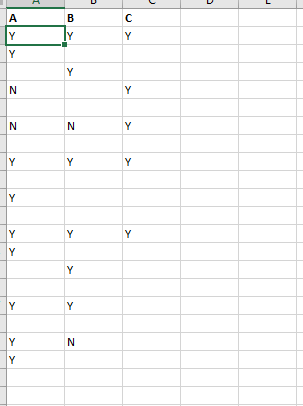Thank you so much! Here is the "dput" output for you to reconstruct the data, at least partially.
structure(list(SDFASDF = c(9L, 9L, 1L, 1L, 1L, 1L), X1 = c("",
"", "", "", "", "C"), X2 = c("P", "", "C", "", "C", "C"), X3 = c("",
"", "", "", "", ""), X4 = c("P", "C", "", "", "", ""), X5 = c("",
"", "", "", "", ""), X6 = c("", "", "", "", "", ""), X7 = c("",
"", "", "", "", ""), X8 = c("", "", "", "", "", ""), X9 = c("",
"C", "", "", "", ""), X10 = c("", "", "", "", "", ""), X11 = c("",
"", "", "", "", ""), X12 = c("", "", "", "", "", ""), X13 = c("",
"", "", "", "", ""), X14 = c("C", "C", "", "", "", "C"), X15 = c("",
"", "", "", "", "C"), X16 = c("", "", "", "", "", ""), X17 = c("",
"", "", "", "", ""), X18 = c("", "", "", "", "", ""), X19 = c("",
"", "", "", "", ""), X20 = c("", "", "", "", "", ""), X21 = c("",
"", "", "", "", ""), X22 = c("", "", "", "", "", ""), X23 = c("C",
"", "", "", "", ""), X24 = c("", "", "", "", "", ""), X25 = c("",
"", "", "", "", ""), X26 = c("", "", "", "", "", ""), X27 = c("",
"", "", "", "", ""), X28 = c("", "", "", "", "", ""), X29 = c("",
"", "", "", "", ""), X30 = c("", "", "", "C", "", ""), X31 = c("C",
"", "C", "", "C", "C"), X32 = c("", "", "", "", "", ""), X33 = c("C",
"", "", "", "", "C"), X34 = c("", "", "", "", "", ""), X35 = c("",
"", "", "", "", ""), X36 = c("", "", "", "", "", ""), X37 = c("",
"", "", "", "", ""), X38 = c("", "", "", "", "", ""), X39 = c(NA,
NA, NA, NA, NA, NA), X40 = c(NA, NA, NA, NA, NA, NA), X41 = c("",
"", "", "", "", ""), X42 = c("", "", "", "", "", ""), X43 = c("",
"", "", "", "", ""), X44 = c("", "", "", "", "", ""), X45 = c("",
"", "", "", "", ""), X = c(NA, NA, NA, NA, NA, NA), X.1 = c(NA,
NA, NA, NA, NA, NA), X.2 = c(NA, NA, NA, NA, NA, NA)), row.names = c(NA,
6L), class = "data.frame")
So, in this case, I would like to get (for example) the amount of rows in which only X2 has a C, then the amount of rows where only X2 and X30 have a C, etc...
So the goal here is to be able to be very specific in my column queries. I hope that makes more sense, and thanks, everyone, for your patience!

 My only concern is that it will count the total number of Y's in column A, but I do not want it to count the Ys in column A if there is a Y in column B or C. So, in this example, I would want the output for A to be 3.
My only concern is that it will count the total number of Y's in column A, but I do not want it to count the Ys in column A if there is a Y in column B or C. So, in this example, I would want the output for A to be 3.